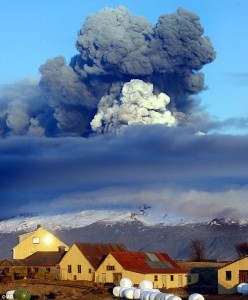This case study, led by COMET Associate Andrew McGonigle (University of Sheffield), describes the development of improved techniques for monitoring volcanic gases. This is vital for assessing hazard levels and issuing pre-eruption evacuation alerts.
The research involved developing instruments that are considerably cheaper, more reliable and accurate than previous iterations, and which also sample far more frequently. They have been used in at least 25 countries and have also become the internationally adopted standard for volcanic gas monitoring and forecasting.

Measuring volcanic gas emissions is crucial to understanding and predicting volcanic activity. However, since its development in the 1970s, the traditional instrumentation (the correlation spectrometer COSPEC) has become outdated and unreliable.
As a result, volcano monitoring was becoming increasingly expensive with lengthy repair times. This was a particular issue in developing countries with high levels of volcanic risk due to their limited budgets. The data also had very poor time resolution (typically 2-3 measurements per week) and large error margins (> 50%), significantly limiting its usefulness.
Identifying the problem, Andrew was involved in leading work to develop new and improved monitoring instruments. This resulted in both new hardware – a compact state of the art commercially available spectrometer (the USB2000) – plus freely downloadable software. Importantly, the USB2000 is considerably cheaper, more compact and reliable than the COSPEC (1kg vs. 20 kg; $4k vs. $60k).
The USB2000 can measure, at a safe distance from the volcano crater, how much background skylight is absorbed by the gases. This is then used to determine emission rates. As the technology has been refined, the time resolution and accuracy of the measurements has also increased.
Alongside this, an upgrade using ultraviolet cameras which image the volcanic gas plumes has led to dramatic improvements in sampling frequency (to once per second) whilst also delivering a direct and accurate measurement of the speed at which the gases are transported from the summit craters. Measurement errors have meanwhile been reduced from > 50% for the COSPEC to 15% for the USB2000 and UV camera approach.
The USB2000 has had widespread international impact and is now considered to be the new standard in measuring volcanic gas emission rates. It is used at almost every degassing volcano on the planet, in over twenty five countries and on every continent. These include Costa Rica, Nicaragua, New Zealand, Mexico, Colombia, Ecuador, El Salvador, France (Réunion), Vanuatu, the Democratic Republic of Congo, the USA, Italy, Russia, Japan, Indonesia and Chile.
The United States Geological Survey (USGS), Montserrat Volcano Observatory, and Italian Istituto Nazionale di Geofisica e Vulcanologia for example are all using the USB2000 to monitor volcanoes in far more detail than previously possible, providing new insights into how these systems work and allowing them to better determine hazard levels. Importantly, the technology has also allowed valuable volcanic gas data to be gathered across the developing world.
The usefulness of the USB2000 has been expanded through a series of freely downloadable software (VolcanoSO2.exe, Vulcamera and UVolc), which facilitate the use of the USB2000 (and USB2000+ upgrade) and UV cameras by volcanologists, most of whom are non-expert in the underlying science of spectroscopy.
Since 2008, the programs have been downloaded by over 80% of the global user community. For example, the Kamchatka Volcanic Eruption Response Team in Russia have been using the UVolc software for controlling miniature USB2000+ spectrometers that are measuring the volcanic gas released by a number of eruptions, finding the code easy to use and leading to far more accurate results than previously possible.
The impact of the research was recognised through the Rolex Award for Enterprise and has also received extensive media coverage by, for example, the National Geographic and Discovery channels, BBC website, and over 1,000 articles in 27 countries including in The Telegraph, The Observer, El Pais, Le Monde, International Herald Tribune, Wired, Esquire, Geographical Magazine and La Repubblica.
References:
McGonigle, A.J.S., (2007) Measurement of volcanic SO2 fluxes with differential optical absorption spectroscopy, J. Volcanol. Geotherm. Res., 162, 111-122. doi: 10.1016/j.jvolgeores.2007.02.001
Kantzas, E.P., A.J.S. McGonigle, G. Tamburello, and R.G. Bryant (2012), UVolc: A software platform for measuring volcanic SO2 fluxes, Computers & Geosciences, 40, 194-199. doi: 10.1016/j.cageo.2011.07.011
McGonigle, A.J.S., A. Aiuppa, M. Ripepe, E.P. Kantzas, and G. Tamburello (2009), Spectroscopic capture of 1 Hz volcanic SO2 fluxes and integration with volcano geophysical data, Geophys. Res. Lett., 36, L21309 doi: 10.1029/2009GL040494
Kantzas, E.P., A.J.S. McGonigle, G. Tamburello, A. Aiuppa, and R.G. Bryant (2010), Protocols for UV camera volcanic SO2 measurements, J. Volcanol. Geotherm. Res., 194, 55-60. doi: 10.1016/j.jvolgeores.2010.05.003
Tamburello, G., E.P. Kantzas, A.J.S. McGonigle, A. Aiuppa, and G. Giudice (2011), UV camera measurements of fumarole field degassing (La Fossa crater, Vulcano Island), J. Volcanol. Geotherm. Res., 199, 47-52. doi: 10.1016/j.jvolgeores.2010.10.004
